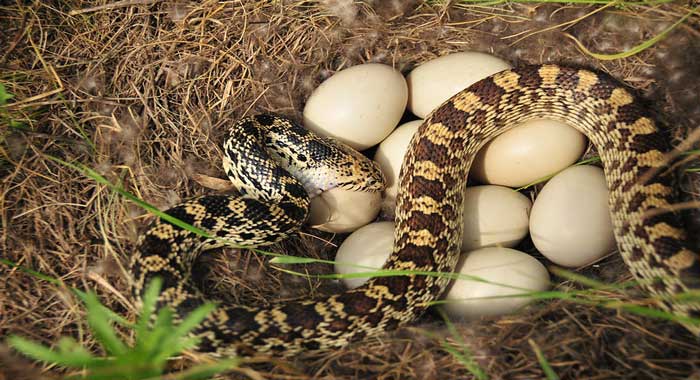While many people are terrified of snakes, others are intrigued by them. Isn’t it cool to have a snake as a pet? Snakes are one-of-a-kind pets because of their powerful physique and the sleekness of their scales. While they’re undoubtedly fascinating, many people are unsure whether or not they’d make suitable pets.
A pet snake can be a wonderful friend; they are peaceful, stunning creatures that don’t have to give them time or clean up their poo. They are easy to maintain, but they need a specific food routine to keep them happy and healthy.
Because they need a meat-based diet, which many people find disturbing, but it’s the truth that snakes are carnivores and cannot live as vegetarians. But some kinds do not eat mice or other creatures. Snakes that don’t eat mice are uncommon. Many people don’t know that these types of snakes exist because there aren’t many of them.
Whether you’re searching for something different or a less unpleasant way to eat, we’ve got you covered. Below are the types of pet snakes that don’t eat mice and can fit your desired needs.
Garter Snakes
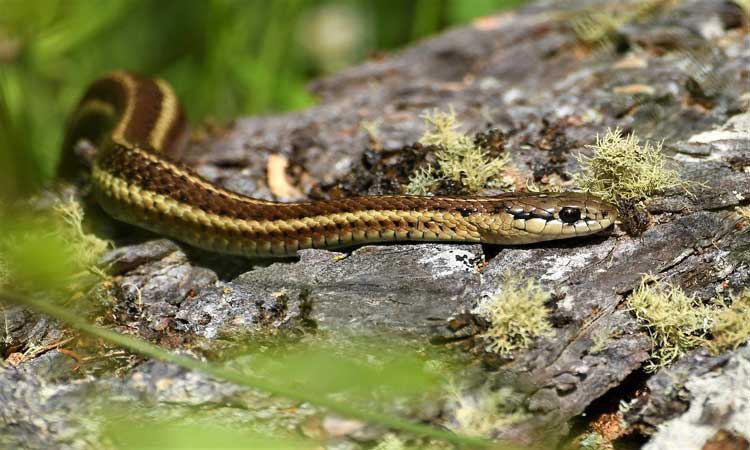
Garters are one of the common snakes in the US, and they also make excellent pets. They aren’t as attractive to some people as other snakes. They are a little snake that is ideal for folks who are afraid of giant pythons.
Garter snakes are a brilliant option for people who prefer small snakes because they never grow more than 39 inches and are harmless.
Garter snakes come in a wide variety of colors and patterns; red, yellow, white, greenish, blue, or brown stripes are familiar. Between their bars, these snakes feature a checkerboard pattern.
These snakes eat anything they can control, which means they will eat creatures about their size, but they will also eat other insects, such as frogs insects, lizards, earthworms, snails, leeches, and fish.
To ensure that they are getting all of their nutrition, you must give them a balanced diet, and the number of times they must eat will vary based on the prey used. For instance, if Snakes eat worms every two weeks, fish-eaters should eat every five days.
Also, when you buy, make sure to ask if the snake will eat non-live food.
Ribbon Snakes
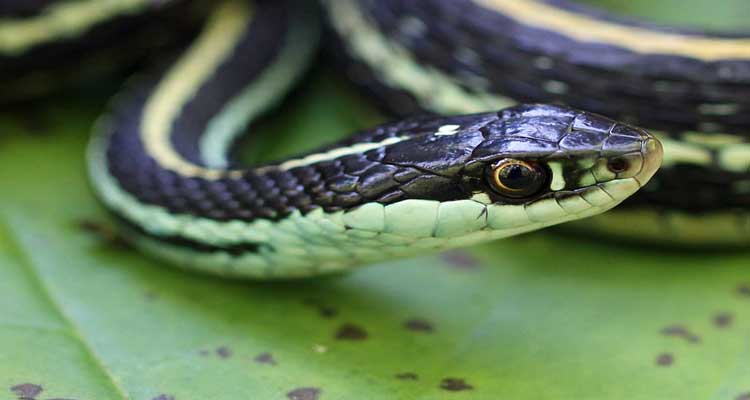
Ribbon snakes look a lot like garter snakes and are sometimes confused with them. These are smaller snakes, similar to garter snakes, that are easy to care for by beginners. Snakes of this kind are common throughout the eastern United States and southeastern Canada.
The stripes on ribbon snakes are brighter than garter snakes. Ribbon snakes also have longer tails, which typically account for one-third of their overall body length. Ribbon Snakes range in size from 16 to 35 inches in length. It features three bright yellow lines running parallel to the length of the body and is black.
They also have good personalities that make them easy to handle. Ribbon snakes food is earthworms, nightcrawlers, guppies, silversides, and tadpoles. Larger prey, such as a frog, can be offered on occasion.
If you want to keep a ribbon snake as a pet, you can feed it invertebrates, but make sure the diet is well-balanced and includes multiple food sources to guarantee adequate nutrition. But do not feed red wigglers to your pet snake because they are harmful.
Water Snakes
A water snake is an excellent addition to pet snakes that don’t eat mice. They prefer to live where there is water. As a result, they’ve learned to eat creatures that live in water, such as frogs and fish. A pet water snake, like garter and ribbon snakes, can be given insects and worms.
The triangular-shaped head, muscular body, and keeled skin of water snakes make them easily recognizable. Water snakes come in various colors and sizes, and their patterns and lengths can differ substantially. Some snakes are only two feet long, while others can grow to be triple that.
Water snakes’ food source is Frogs and fish, but you can also give them insects and worms. But be careful when you are giving frogs as they carry parasites that might hurt your pet snake.
If you only feed your snake fish or frogs, you’ll need to supplement their diet to ensure they get all of the nutrients they need.
Water snakes can be highly appealing at times, grow to moderate but manageable sizes, and are easy to feed. On the other hand, they aren’t suitable pets as they can be aggressive and don’t constantly adjust well to being handled.
African Egg-eating Snakes
The African egg-eater is a rare exotic pet compared to garter snakes; but, if you can find one born in captivity, they are relatively easy to care for and make excellent pets.
They mainly live in Africa, in woodland or forested areas. All egg-eating snakes are slim and about 30 inches long.
These snakes have a unique physique that enables them to eat eggs as their food source.
Finding eggs that are small enough to eat might be difficult. Quail or finch eggs are suitable for babies. And for the adult, they can eat chicken eggs. Adult snakes can expand their jaws to huge sizes to fit an egg the size of a chicken down their throat.
But It is recommended not to give chicken eggs, and you have to find quail eggs as it is suitable for your snake. These eggs are small and not dangerous to eat for the snake.
These snakes go months without eating after a large meal. Your snake should be alright as long as it is drinking and acting normally. You should take your snake to the veterinarian if it stops drinking or starts acting strangely.
Rough Green Snakes
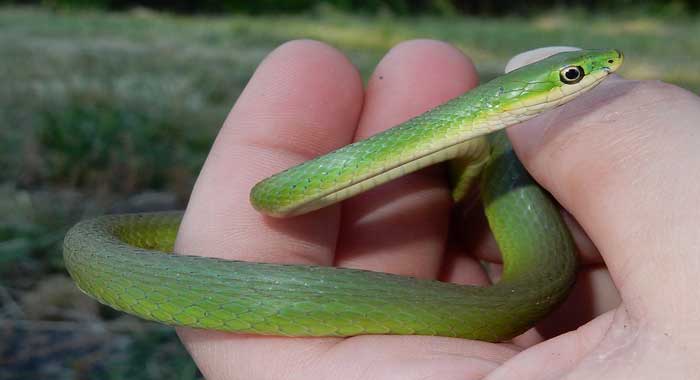
Rough Green Snakes are also one type of pet snake that doesn’t eat mice. These snakes are most common in the North American region. They have a thin body with a brilliant greenback and a yellow belly.
They are usually three feet long and rarely grow to be more than 46 inches long. These snakes are gentle and hardly bite, and they are non-venomous, so if they bite you, they will not harm you. However, it would be best not to overhandle them, and they’ll become upset quickly.
Their food is crickets, caterpillars, spiders, moths, and soft-boiled beetle larvae. Because of their high activity level, lack of tameness and flightiness, and the fact that most of them are wild-caught, these snakes are better suited for intermediate to advanced owners.
But remember, do not overfeed these snakes with live feeders; they are not used to it. Feeding too much can make them stop eating.
Smooth Green Snakes
Smooth green snakes have greenbacks with contrasting yellow bellies. Also common in the North American region. They have smooth dorsal scales & measure between 14 and 20 inches in length.
Smooth green snakes are not ideal as pets for everyone; they are best suited to those who want a snake as a display animal rather than a companion. They are docile like rough snakes. These snakes are nonvenomous. But when they feel insecure, they tend to retreat.
This snake eats spiders, ants, caterpillars, crickets, small cockroaches, moths, snails, and slugs. You don’t have to feed them mice or rodents.
And they should not be handled too much, just like rough green snakes. These snakes become frightened when you overhandle them too much. When a snake is constantly stressed, it may develop unwell or stop eating.
Because they are gathered together in large quantities from the wild, these species are agitated, have eating issues, and are parasite-infested, which explains why they are so cheap and available. You must consider all of this before purchasing this unique insect-eating species.
Check this infographic to know about these snakes at a glance.
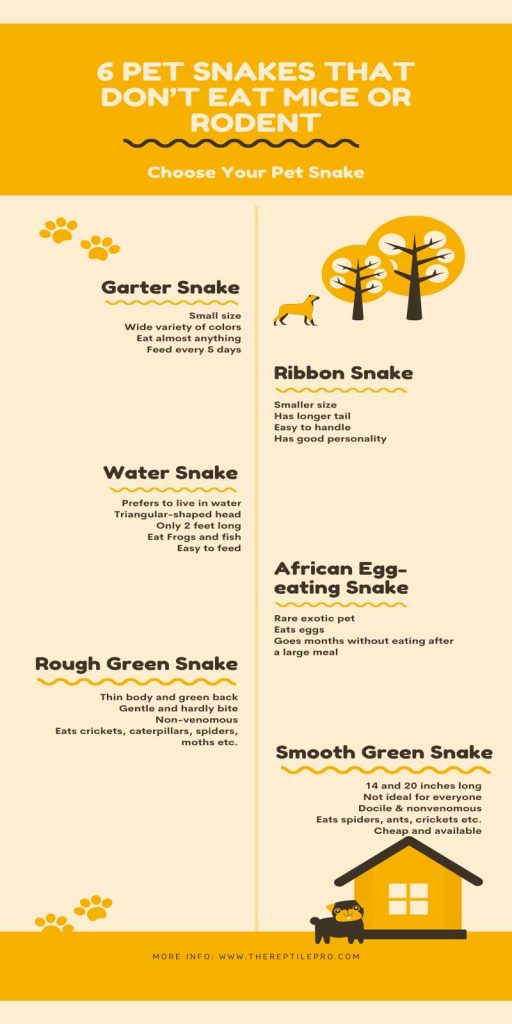
Why should you Own A Snake That Doesn’t Eat Rodents?
There are circumstances and reasons not to feed your pet, such as rabbits, mice, and rats, apart from body size or temperament concerns. Consider the following things:
● Sensitive owner:
Some snake keepers can’t take the messiness of feeding their snakes alive or dead mice because it includes thawing or reheating the dead rat in your microwave or oven, which results in smelly “leaks.”
Furthermore, many owners are sensitive to giving rodents or live creatures. Plus, if the pet snake ruptures and bites into the Rodent, it can make a mess you don’t want to clean up.
● Safety:
It’s possible that feeding your snake live rats will cause harm to it. All snakes, whether insects, other creatures, or warm-blooded rodents, are essentially carnivorous and have an instinct to kill for survival. However, especially if your pet is a beginner snake, the mouse or rabbit you chose as food. As strange as it may seem, if a mouse or rat is starving and more significant than the snake, it may bite before killing it, resulting in damage and illness to your snake.
So, until your snake is capable of managing such prey, you should avoid feeding it rodents. Given the number of feedings that will happen throughout the snake’s life, some owners prefer to avoid this risk.
● Inhumane
Some snake owners believe that feeding a mouse is similar to providing a pet to another pet. They think mice are adorable and even have one as a pet, so feeding them to their snake is disturbing.
When you buy, ask about the snake’s diet from the breeder. If you’re not sure how often to feed your snake, your veterinarian can help you out by creating a feeding routine that fulfills your snake’s nutritional needs.
Wrapping Up
Now You are glad that not all snakes eat rodents, birds, or other larger prey. There are many types of snakes given above, so choose which attracts you the most.
When searching for a pet snake that doesn’t eat mice, keep one thing in mind: see if the snakes eat anything other than mice. Not all snakes will adjust well to a sudden food change. The frequency of feedings is also important to remember.
Also important to remember their feeding plans. Your snake will require a varied feeding plan when feeding insects, fish, eggs, or rodent alternatives to maintain good physical condition.
Depending on your snake’s diet, they may require calcium supplementation and a multivitamin to ensure proper nutrition.
So whatever types of snakes you choose. They will thrive on an insect diet and be a fantastic companion with a well-balanced diet and nutrition.

